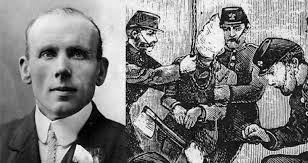The death penalty no longer exists in most Western countries, including England. But in the 1800s, executions were a common form of capital punishment.
While most people did not survive to tell the tale, one man named John Henry George Lee (also known as John “Babbacombe” Lee) survived three execution attempts.

Poor Childhood, Big Dreams
John Lee was born to John Lee Senior and Mary Lee (née Harris) on August 15, 1864, in Abbotskerswell, Devon. His parents were poor and had no money to spare for his education. But John was ambitious — he wanted to earn money quickly and explore the world.
He enlisted in the Royal Navy. But a severe leg injury put him out of commission and made him leave the Navy within a year.
Now broke and facing a bleak future, John got a job as a footman. However, he was soon accused of stealing from his employer and was sentenced to two years of hard labor.
The Murder
After his sentence in 1884, John again got a job as a footman for Emma Keyse. She was a rich widow who lived in the sleepy town of Babbacombe Bay. John established good relations with her and soon became her trusted servant.
On one fatal day on November 15, 1884, Emma was killed — her throat slit with a knife. Her head had three lacerating puncture wounds. Her killer unsuccessfully attempted to burn her corpse to cover up the murder.
The police suspected John of the murder since he was the only man living in the house. They found a blood-soaked knife in his bedside drawer and his arm was stained with blood. John explained that he injured his arm after he broke a window to get to Emma’s bedroom where he had seen a raging fire. But no one believed him.
The police found no witnesses to the crime or any motive for John to kill Emma. Any evidence they had was circumstantial. Since forensic science had yet to be fully developed, there was no way to confirm if the blood on John’s arm belonged to him or Emma.
Eventually, John was arrested for Emma’s murder and put on trial.
The Failed Hangings
The court appointed a local solicitor named Reginald Gwynne Templer as John’s attorney. But a couple of days before the court proceedings began, he was relinquished of his duties due to poor health. His brother Charles Templer took over the case but he was an incompetent lawyer who had a long record of lost cases.
Throughout the trial, John kept claiming that he was innocent. Despite the evidence against him being circumstantial, it was still damning and his lawyer ended up losing the court battle.
John was sentenced to execution by hanging, but fate had other plans. On the day of the execution, John did not die.
James Berry, the hangman, and the warden made several attempts to get the trap door that would leave John hanging to work but it refused to budge. After three unsuccessful attempts, they finally had to stop.
Sir William Harcourt, the Home Secretary, later stated while changing John’s punishment to life imprisonment, “It would shock anyone if a man had thrice to pay the pangs of imminent death.”
Potential Causes of the Failed Hangings
Many people wonder why the hanging mechanism failed three times. Was it only a mechanical error or was it divine intervention that saved John’s life?
According to prison officials, it rained on the day of the hanging. This may have caused the scaffold’s wooden planks to swell with rainwater and fail. But upon examining the planks later, they were completely dry. The procedures for hanging had been systematically followed so the mechanism had no reason to fail even once.
Meanwhile, many believed that it was the unseen hand of god that had saved John.
Later, other people studied the intricacies of the mechanism’s failure. An in-depth assessment of the scaffold showed that its critical parts needed stricter maintenance to keep it working smoothly. It’s possible that some components jammed. This could have caused the trap door to remain closed even under a normal person’s weight. Hence, fortune and negligence saved John thrice.
But even this theory doesn’t answer everyone’s questions such as why prison officials didn’t address the mechanical issues after the second failed attempt. To this day, there have been no explanations in this regard.
Experts finally closed the investigation believing that a mechanical failure was the most rational, albeit run-of-the-mill, explanation for John’s failed hangings.
A Strange Twist in the Tale Five Decades Later
Five decades later, when experts used forensic science to solve John Lee’s case, they discovered that the killer wasn’t John.
Rather, it was his first attorney, Reginald Templar. Reginald’s relations with Emma had become strained. In a fit of rage, he murdered her and then framed John by pinning the evidence on him.
It turns out that John was telling the truth all along when he said that he was innocent. He also allegedly told solicitors that Reginald was in the house the night of the murder.
This bizarre conclusion finally brought a suitable closure to a strange event that nearly claimed the life of an innocent man who was saved due to a stroke of luck.
An Obscure Death
In 1907, after a penal servitude of 22 years, John was finally released from prison. After his release, it is believed that he either traveled abroad or spent the remainder of his life in a South West workhouse.
Later, a death certificate of a man named John Lee was discovered. It stated that he was a journeyman or a painter and died of “myocardial degeneration.”
In 2009, two people found an unmarked grave in Milwaukee, Wisconsin which they believe to be John Lee’s grave.
According to their research, John died in 1945 at the ripe old age of 81. Upon fleeing to the United States, he deserted his wife and daughters in Britain and had another family in the US.
Despite an obscure end in an unmarked grave, John Lee’s story lives on as “the man they could not hang.”

